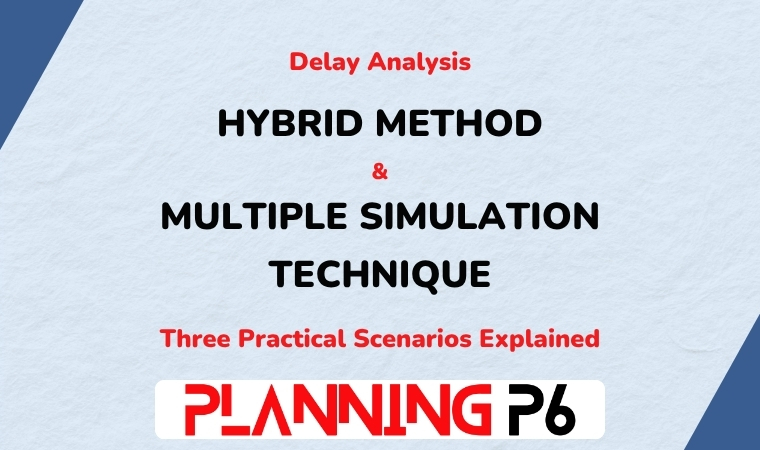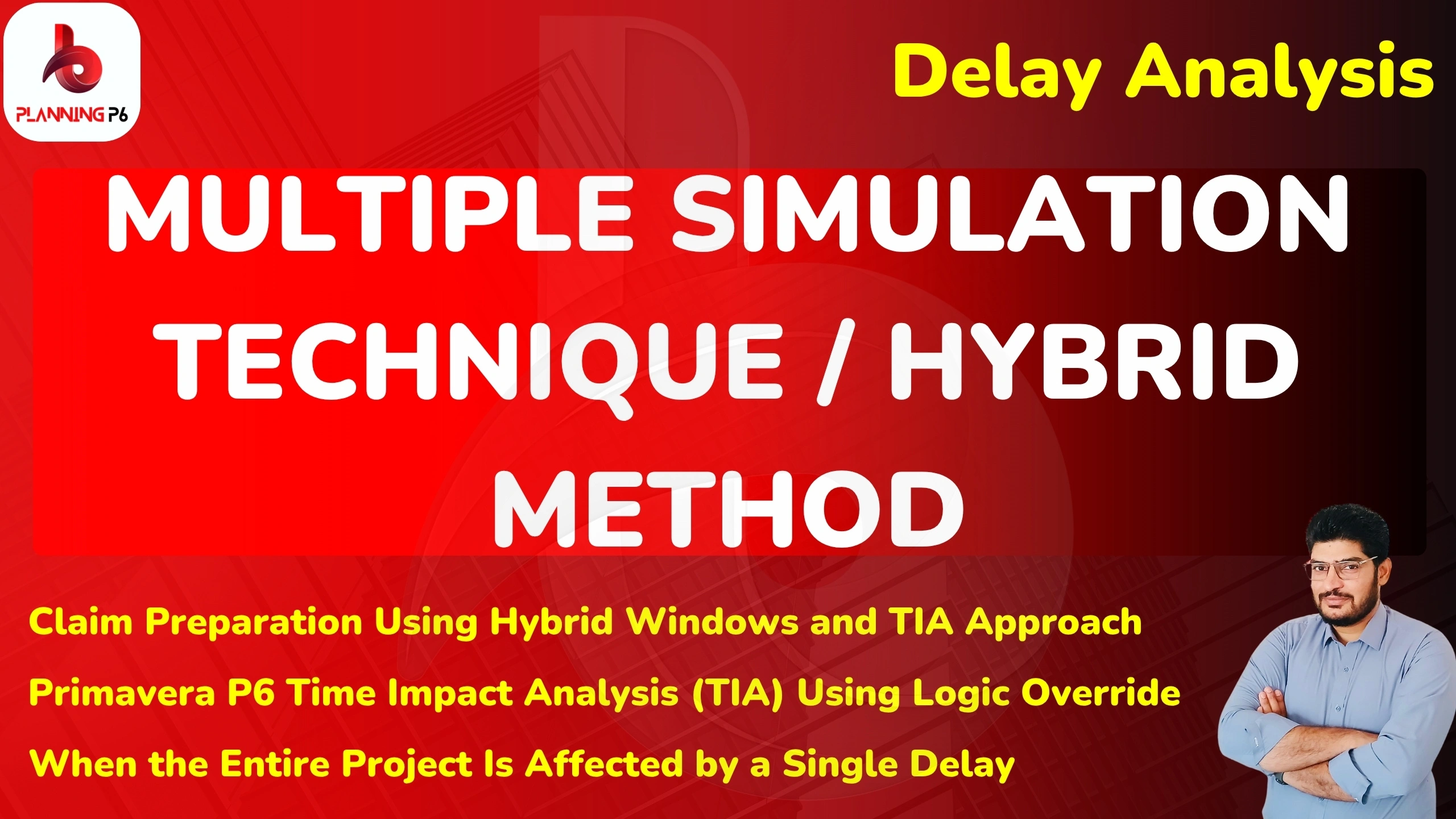
- Delay Analysis Using the Multiple Simulation Technique in Primavera P6 (AACE RP 29R-03 Guide)
- How to Perform Time Impact Analysis (Windows Method) in Primavera P6
- Primavera P6 Delay Analysis Explained: Windows + Time Impact Hybrid Method
- Step-by-Step Delay Analysis in Primavera P6 Using Multiple Simulation Technique
- Windows Analysis vs Time Impact Analysis in Primavera P6 — Which Is Better?
- AACE 29R-03 Delay Analysis in Primavera P6 | Complete Tutorial for Planners
- Primavera P6 Time Impact Analysis (TIA) Using Logic Override — Full Guide
- How to Combine Windows and TIA Methods for Accurate Delay Analysis in P6
- Multiple Simulation Technique Explained | Delay Analysis in Primavera P6
- Primavera P6 Forensic Delay Analysis: Step-by-Step Using AACE Standards
- How to Do Contractual Delay Analysis Using Windows Method in Primavera P6
- Real-Time Delay Analysis in Primavera P6 | Windows + Progress Override Method
- AACE RP 29R-03 & RP 52R-06 Delay Analysis Using Primavera P6 | Full Breakdown
- EOT Claims and Delay Analysis in Primavera P6 Using Time Impact Technique
- Primavera P6 Delay Claim Preparation Using Hybrid Windows and TIA Approach
- Best Delay Analysis Method in Primavera P6: Hybrid Windows + TIA Explained
Tutorial:
Description:
Delay analysis is one of the most critical aspects of project controls, especially for planners, schedulers, and claim analysts working with Primavera P6.
Among the several methodologies recognized by AACE International, one of the most practical and defensible approaches is the Multiple Simulation Technique, which effectively combines Windows Analysis and Time Impact Analysis (TIA) into a single, hybrid process.
This combined technique provides a realistic, evidence-based representation of project performance, it analyzes both what actually happened (observational view through Windows Analysis) and what could have happened (prospective modeling through Time Impact Analysis).
It is widely used in complex engineering, oil & gas, and infrastructure projects where transparency, consistency, and contractual defensibility are essential.
In this article, we’ll explore three practical scenarios that explain how to implement the Multiple Simulation Technique effectively inside Primavera P6:
- Scenario 1 – Windows Analysis:
The first scenario demonstrates how to perform Windows Analysis on a monthly basis, dividing the project into analysis windows to observe real progress, track changes in the critical path, and assess delays period by period. - Scenario 2 – Time Impact Analysis (Windows Method with Logic Override):
The second scenario focuses on performing a Time Impact Analysis using actual dates and the Progress Override option in Primavera P6 — a method often required by clients for consistency and transparency in contractual delay assessments. - Scenario 3 – Single Delay Impact on Entire Project:
The third scenario explains how to handle situations where a single dominant delay event affects the entire project. It describes a simplified, quick Time Impact Analysis approach to evaluate the overall impact efficiently without conducting multiple detailed simulations.
Together, these three scenarios illustrate a complete framework for delay analysis in Primavera P6, combining forensic accuracy, AACE compliance, and practical project control insight.
Scenario 1: Windows Analysis (Observational Delay Review)
The Windows Analysis method divides the project schedule into smaller, logical time segments — usually monthly or quarterly “wThe Windows Analysis method divides the project schedule into smaller, logical time segments — usually monthly or quarterly “windows.” Each window allows the planner to observe how delays evolved, how the critical path shifted, and how progress compared to the baseline.
Step-by-Step Procedure
- Perform the Windows Analysis Monthly
Break the project into monthly update periods to isolate and measure slippages.
- Analyze Overall and Sectional Milestones
Assess delay impact on both overall completion and sectional milestones.
- Evaluate Each Delay Event Separately
Analyze each delay within its window for traceable and precise cause-effect understanding.
- Remove Out-of-Sequence Activities
Before running schedules, fix logic issues to maintain accurate results.
- Check Activity Calendars
Ensure each activity uses the correct working calendar, especially when multiple calendars exist.
- Organize Window Files Properly
For each window, maintain a record folder containing:
- Pre- and Post-Impact XER files
- PDF Gantt charts and schedule logs
- Impact fragnet diagrams (PNG/PDF)
- Pre/Post impact comparison reports
- Windows Analysis narrative or summary
- Save Each Baseline as a User Baseline
This allows consistent referencing and transparent audit trails.
This observational method (AACE RP 29R-03) forms the foundation for professional forensic delay analysis, ideal when detailed project updates are available.
Scenario 2: Time Impact Analysis (Windows Method with Logic Override)
“Time Impact Analysis (Windows Analysis) using actual dates with Logic Override.”
This hybrid instruction means the analysis should be carried out window by window, using actual site progress and Progress Override logic in Primavera P6.
1. Where Is This Requirement Found?
This requirement often appears in the Employer’s Requirements or Special Conditions of Contract.
It’s not an AACE rule but a client-specific requirement — designed to ensure all contractors use a consistent, transparent, and verifiable method.
2. Why Time Impact Analysis (Windows Method)?
- Divides projects into time windows (monthly/quarterly)
- Uses actual progress data, not assumptions
- Measures delays in real time, not retroactively
- Builds a step-by-step delay trail, minimizing disputes
This method merges Windows Analysis (observational) and TIA (prospective) — a balanced approach endorsed by many international projects.
3. Methodology in Primavera P6
- Update progress for each window with real data.
- Apply Progress Override logic to reflect site behavior.
- Insert delay fragnets to model each delay event.
- Reschedule and measure the impact on project completion.
- Summarize results to establish total entitlement.
This creates a transparent, defensible demonstration of delay impacts consistent with AACE RP 29R-03 and RP 52R-06.
4. Benefits and Risks
For the Client:
- Transparency and control
- Consistent, step-by-step analysis
- Protection from inflated claims
- May expose employer-caused delays clearly
For the Contractor:
- Fair recognition of legitimate delays
- Stronger, data-backed claims
- Trusted by courts and arbitrators
- Cannot exaggerate or shift responsibility
5. Why Clients Prefer It
When the Entire Project Is Affected by a Single Delay
How to Perform a Quick TIA
- Insert the Delay Activity After Its Related Task
Place the delay directly after the activity it impacts. - Reconnect All Dependent Activities
Re-establish logic links to ensure accurate delay propagation. - Run and Compare
Reschedule to see how much the delay extends the finish date. - Assess Results
The difference between pre- and post-impact schedules shows total delay duration.
Why This Works
This simple yet powerful method is ideal when:
- One delay affects the entire critical path
- The delay’s cause and duration are clearly defined
- The planner needs a fast, defensible impact assessment
CONCLUSION
Effective delay analysis is the cornerstone of fair and transparent project management. The Multiple Simulation Technique, as applied in Primavera P6, offers planners and claim analysts a balanced framework that combines accuracy, clarity, and defensibility.
This hybrid methodology — blending Windows Analysis and Time Impact Analysis (TIA) — aligns closely with AACE Recommended Practice 29R-03 and 52R-06, ensuring compliance with internationally accepted forensic scheduling standards.
Through the three scenarios described in this article, we’ve explored how this technique can be applied in real project environments:
- Scenario 1 – Windows Analysis:
This observational method breaks the project into monthly or quarterly windows to study how progress, slippages, and critical paths evolved over time. It focuses on what actually happened, allowing planners to trace the cause and effect of every delay using transparent, evidence-based data.
- Scenario 2 – Time Impact Analysis (Windows Method with Logic Override):
This scenario introduces the contractually preferred approach used by many clients — the Windows-based TIA performed with Progress Override. It combines real progress data and delay event modeling, providing a clear, defensible timeline of delay impacts. This method ensures consistency, fairness, and visibility, benefiting both the Employer and the Contractor.
- Scenario 3 – Quick TIA for a Single Global Delay:
Sometimes, one dominant delay — such as land handover, drawing approval, or design change — controls the entire project. This simplified TIA approach allows planners to model the event quickly by inserting the delay fragnet, reconnecting logic, and observing its total effect on the completion date. It is practical, efficient, and fully defensible when supported by accurate data.
Together, these three techniques represent a complete forensic toolkit for analyzing delays in Primavera P6. The Multiple Simulation Technique enables you to:
- Capture both observational and modeled delay perspectives.
- Maintain logical integrity across project updates.
- Demonstrate causation and entitlement clearly during claims or disputes.
- Comply with AACE and FIDIC standards for fair, transparent schedule evaluation.
- Build an auditable record of pre- and post-impact conditions for each delay window.
In today’s construction and EPC industries, where schedule performance often determines contractual outcomes, mastering these methods in Primavera P6 is not just a technical skill — it’s a professional advantage.
The Multiple Simulation Technique empowers planners to deliver analyses that are accurate, data-driven, and defensible — ensuring that both Employers and Contractors can reach fair conclusions based on real project behavior, not assumptions.
Whether you are preparing a claim submission, defending a delay analysis, or auditing project performance, applying this structured approach will strengthen your credibility and align your work with international best practices.






